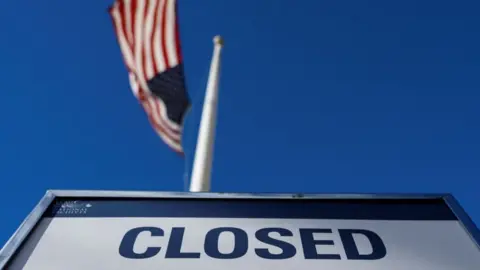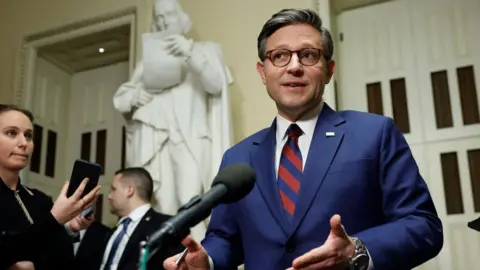 Reuters
ReutersThe United States is heading toward another government shutdown after the lower house of Congress failed to pass a spending bill aimed at keeping federal agencies open.
The funding is set to expire at midnight Friday unless Republicans and Democrats can agree on a path forward.
Here's a look at how we got here and what it means for Americans — and for Donald Trump.
Why is this shutdown looming?
 Getty Images
Getty ImagesMany federal government agencies rely on annual funding approved by Congress.
Each year, these agencies submit their requests, which Congress must adopt, and the president must sign the budget law for the following fiscal year.
If no agreement is reached, all non-essential discretionary functions of the U.S. government will cease.
In September, both parties passed a bill to maintain government funding until December 20.
This week, three days before lawmakers left for the holidays, House Speaker Republican Mike Johnson released a bill to extend funding through March.
It was agreed with Democratic leaders, but included some measures like a pay raise for lawmakers that made some Republicans unhappy.
Tech billionaire Elon Musk, a Trump ally, voiced his opposition to the plan, then the president-elect signaled he wanted his party to kill it, which happened.
A second, slimmed-down bill was introduced in the House Thursday evening, but failed to garner enough votes to pass.
 Getty Images
Getty ImagesWho is affected by a government shutdown?
If no deal is reached by midnight, the United States will experience its first shutdown since early 2019.
Essential workers continue to work as normal, some of them without pay, while government employees deemed non-essential are temporarily placed on unpaid leave.
Border protection, hospital medical care, law enforcement and air traffic control will continue to operate.
But services such as the food assistance program, federally funded preschools, student loan provision and food inspections, and national parks will be reduced or closed.
While Social Security and Medicare checks are being mailed, benefit verification and card issuance stops.
There could also be travel delays if the standoff continues.
“An extended closure could result in longer wait times at airports,” said Carter Langston, a spokesperson for the Transportation Security Administration.
Why did Elon Musk oppose the bill?
 Getty Images
Getty ImagesThe Tesla boss was tasked with identifying spending cuts by co-leading the Department of Government Effectiveness (DOGE) project.
It is not a formal government department, but it has committed to $2 trillion in savings.
On Wednesday, he posted dozens of messages on X, the platform he owns, to express his disgust with Mike Johnson's bill.
Amplifying some false statements about the content of the bill, he called it criminal and scandalous.
After Musk stirred up opposition, Trump and JD Vance, the new vice president, delivered the final blow to Johnson's deal that evening.
They said in a joint statement that they wanted simplified legislation without the Democratic-backed provisions included by Johnson.
They also called on Congress to raise or eliminate the debt ceiling, which determines how much the government can borrow to pay its bills.
What is happening now?
Johnson has promised to find a solution Friday, so there will be plenty of wrangling on Capitol Hill as time runs out.
But to get the necessary support in the House, he will need Democratic votes.
Democrats say they will only support the original bill that Trump and Musk opposed.
If no agreement is reached, US federal agencies will close their doors at midnight.
How common are shutdowns in the United States?
Quite common. President Ronald Reagan oversaw eight shutdowns during his term, although all were relatively brief.
And there were three when Donald Trump was president, including the longest in history at 36 days which ended in January 2019.
This occurred over disagreements over funding for a wall on the Mexican border.
The Congressional Budget Office (CBO) this is estimated to have reduced economic output of approximately 11 billion dollars, of which 3 billion it never recovered.

Budget shutdowns are almost unique to American politics.
In the American system, different branches of government must reach agreement on spending plans before they can become law.
In most countries, budget votes become votes of confidence in the government itself. But because the United States has equal and often divided branches of government, this is not the case.
Why does Trump want to raise the debt ceiling?
Also known as the debt ceiling, this is a law that limits the total amount the government can borrow to pay its bills.
This includes paying federal employees, the military, Social Security and Medicare, as well as interest on the national debt and tax refunds.
From time to time, the U.S. Congress votes to increase or suspend the cap so it can borrow more.
Trump adding that condition to the deal was an unexpected demand that made it more difficult for right-wing Republicans, who often oppose increasing government spending to support the bill.
The debt ceiling will have to be raised in the coming months, regardless of the promised efficiency efforts.
But by demanding it happen now, some analysts say Trump is signaling the cost of his proposed tax cuts and that tighter border restrictions will strain the caps. And he prefers that the fight for the increase take place before he takes office.
Democrats generally favor an unconditional debt ceiling hike, but they are in no mood to help Republicans at the moment.
The risk for Trump is that the mini-rebellion will erode the mantle of invincibility he has worn since the election.
And it raises questions about his party's ability to deliver on campaign promises that require legislation.
#government #shuts
